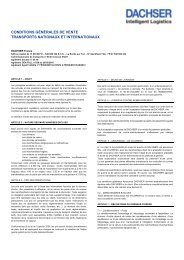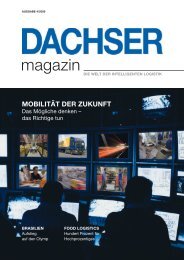You also want an ePaper? Increase the reach of your titles
YUMPU automatically turns print PDFs into web optimized ePapers that Google loves.
<strong>Co</strong>ver story<br />
by establishing locations in the UK, Austria,<br />
Switzerland and the Benelux countries.<br />
Another revenue stream was created in the<br />
late 1950s as a result of air & sea freight<br />
activities in the United States. Today,<br />
<strong>Dachser</strong> has 305 locations, is represented<br />
with its own branches in more than 20 countries<br />
aro<strong>und</strong> the globe, and is proactively<br />
placing special focus on the booming regions<br />
of Asia and eastern Europe.<br />
The logistics provider is thus consistently<br />
continuing to follow its own philosophy.<br />
“Family-owned businesses are reliable because<br />
their planning extends beyond the<br />
short-term, and they adhere to long-term<br />
business concepts that they are passionate<br />
about and want to achieve,” says Bernhard<br />
Simon, spokesman for the <strong>Dachser</strong> management.<br />
“The ability to think outside the box<br />
is crucial: Which customer needs will be<br />
driving the market in the future? Is the<br />
customer ready for innovation? Will he pay<br />
more, if need be, for a new technology? How<br />
might the European or worldwide consumer<br />
be expected to respond to a new idea?”<br />
<strong>Co</strong>urage to innovate<br />
At <strong>Dachser</strong>, innovations don’t spring from a<br />
single inventor, but instead result from structured<br />
processes. Ideas can originate from any<br />
employee. This produces creative solutions for<br />
the dynamic development of customer relations<br />
or for greater sustainability. “Recognizing<br />
a structure is one side of it, implementation<br />
is the other,” says Dr Andreas<br />
Froschmayer. “We want people to have the<br />
courage to innovate. This is the only way to<br />
produce new possibilities. At the same time,<br />
we continuously tell those involved: ‘Please do<br />
everything possible to avoid putting the<br />
whole ship in danger; don’t drill any holes<br />
below the water line!’” The confidence in<br />
the future within the scenarios of <strong>Dachser</strong>’s<br />
internal think tank, as well in the various<br />
external studies, is based on knowledge of<br />
the innovative power that lies within industry<br />
and science. Of the experts surveyed<br />
>><br />
Recognizing a<br />
structure is<br />
one side of it, implementation<br />
is the other Dr Andreas Froschmayer<br />
18 DACHSER magazine<br />
Trends and prospects for the future<br />
The future is coming: Here is a selection of trends in logistics.<br />
Sustainability: The subject itself is not new, but it is taking on a broader dimension.<br />
The link between the economy, the environment and social factors<br />
has come to the attention of the industry. More and more companies view the<br />
“environmental footprint” as an integral part of corporate responsibility, increasingly<br />
making it a part of their own brand concept.<br />
Values and mission: In part due to the economic and financial crises,<br />
companies are increasingly emphasizing purpose and social responsibility in<br />
their activities as a certain kind of counterbalance. Mission statements are<br />
being scrutinized and further developed.<br />
<strong>Co</strong>mplexity: Sustainable economic activity goes hand-in-hand with a decentralized<br />
management structure. Working in networks is required to achieve<br />
worldwide customer solutions. This is accompanied by a new concept of corporate<br />
management that is marked by cybernetic interaction and flattened<br />
hierarchies (see also DACHSER magazine 3/09, p. 8-9; www.dachser.com/<br />
cybernetics).<br />
Efficiency: To optimize transport flows, people in the logistics, industry, public<br />
policy and research sectors are working at full steam to design modern processes.<br />
The efficiency of the modes of transport is viewed as key to the future.<br />
Energy: The central question in the transport sector: Which resources will be<br />
available in the future to maintain mobility as the pacemaker of globalized economic<br />
and social systems? Renewable energies are viewed as the alternative<br />
to fossil fuels and as an opportunity for the future.<br />
DACHSER magazine will address all of these topics with various reports in<br />
coming issues. Dr Andreas Froschmayer<br />
for the SMI Logistics Study 2025, 68 percent<br />
are convinced that innovation in transport<br />
logistics will make a substantial contribution<br />
to reducing the consumption of resources.<br />
Such optimization is also viewed as key to<br />
mobility in 2030 in the Renewbility study:<br />
“Utilization of vehicle capacities can be increased<br />
– and the proportion of unloaded<br />
driving minimized – through optimization of<br />
the logistics structures with measures such as<br />
increasing contract logistics, optimizing<br />
routes, reducing plant traffic, increasing the<br />
market share of efficient services providers,<br />
and consolidating goods flows through modern<br />
scheduling and telematics systems.” At<br />
<strong>Dachser</strong> this vision has long been a part of<br />
day-to-day logistics activities, thus confirming<br />
the idea posited by comic artist Arthur<br />
Radebaugh. Cars might not yet be able to fly,<br />
but he was right about one thing: the future<br />
is closer than we think. M.Schick<br />
For more information please visit:<br />
www.renewbility.eu<br />
www.supplyinstitute.org




